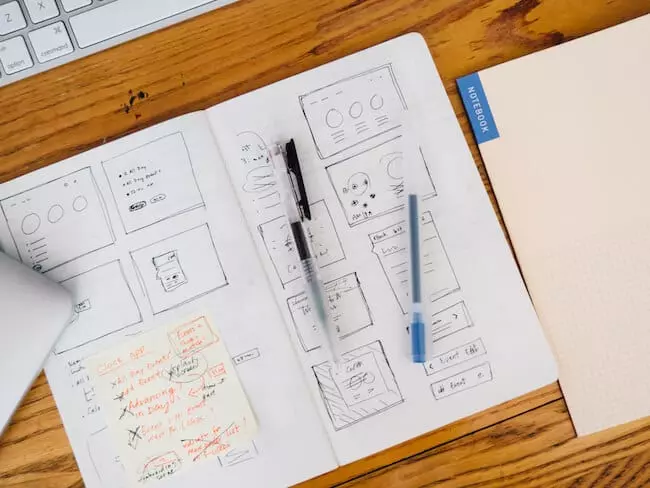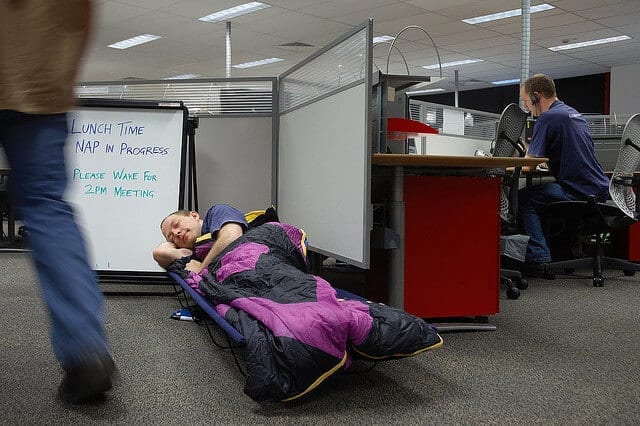
This article is from Snacknation. View their site at the bottom.
There’s a silent killer in your workplace.
It lurks in the shadows, depleting your energy, sacking your concentration, and shaking your confidence.
Your co-workers talk about it in hushed tones (if at all), and your boss is in denial of its very existence…
Its name?
Stress.
It’s no joke. Countless studies show that excess stress can cause real physical symptoms like headaches, upset stomach, increased blood pressure, chest pain, and trouble sleeping.
That’s not to mention its role in mood disorders like anxiety and depression. In the infographic below, we’ll take a look a look at the alarming costs of workplace stress, the warning signs that you’re too stressed, and 6 simple methods for reducing stress at work.
OSHA (The Occupational Safety and Health Administration) deemed stress a “hazard of the workplace,” and estimates put the cost of stress at $190 billion a year in annual healthcare bills.
And it’s not isolated to specific industries – the problem is widespread. 65% of adults say that work is the source of their significant stress.
On top of that, a joint team of Harvard and Stanford researchers looked at data from the General Social Survey and the American Community Survey and found that stressful jobs might actually lower your life expectancy.
The key to learning how to manage stress at work so to keep it at a healthy level and make sure it doesn’t become overwhelming. Easier said than done, right? We’re here to help. Here are 6 tried and true methods for learning how to relieve stress at work – so you can get back to kicking butt.
1. Make Time For Workplace Wellness
Your workplace should support your sustained wellbeing throughout the day. Say it again so you don’t forget. Hard work needs balance to be sustainable. Now, not everyone is lucky enough to have a dedicated home office, but there are plenty of small things you can do to make your work from home experience more enjoyable and healthier. Some excellent items to facilitate this are:
- Greenery in your scenery.
- In addition to improving the air quality, adding indoor plants to your desktop can have a soothing effect and make your space feel calmer.
- A water bottle.
- Keeping yourself hydrated throughout the day helps to keep your brain alert and “moist” which provides ideal conditions for creative thinking and problem solving. It also ensures that your body will remind you to get up and move when you need the bathroom.
- Natural light.
- Creating a bright and natural workspace can immensely support your mood and productivity. In addition, natural light reduces the need for artificial lighting during the day, which can help to save on energy costs!
- A good laugh.
- Laughter is good for the soul and a great way to help reduce stress at work. Try setting up a Laughter Gym at your company to provide a place to let loose!
- Something that smells good.
- Whether it’s a deliciously scented candle or a diffuser with some uplifting essential oils, keeping the environment smelling good can shift your mood and awaken your senses through scent and sight.
- Weekly virtual wellness challenges.
- You may be pretty used to spending all day working on a computer, but staring at a screen for hours is exhausting. A quick fix is to start a weekly wellness competition that will inspire and encourage employees to help handle stress at work. An easy way to get started is by creating a weekly wellness Slack channel or working with a software platform like Nectar to gamify the challenge:
2. Prioritize and Organize

Feeling overwhelmed is a major stressor. A great way to make a major reduction in your stress is to learn how to handle stress at your work by prioritizing and organizing. Here’s how to do it:
- Clarify Goals.
- Before you can prioritize, you have to set clear objectives. Make time to sit with your manager and clarify your goals. sBe sure that your daily activities track back to one of your overarching goals.
- Prioritize Against Goals.
- Don’t set priorities arbitrarily. Use your goals to evaluate the importance of every task. At SnackNation, we teach team members to evaluate each task by asking, “Is this getting me closer to or further away from my goals?” If the answer is anything other than “closer to,” it’s not a priority.
- Focus on 2-3 things Max.
- There’s an old saying – if everything is a priority, nothing is a priority. Focus on the “biggest levers” – that is, the 2 or 3 things each week that will have the biggest impact on your goals.
- Set Deadlines.
- As a general rule, if a task doesn’t have a deadline, it will get pushed aside for one that does. Set realistic deadlines for everything, and everything will get done.
- Use Your Calendar.
- Plan your weeks in your calendar so that you maximize the limited time you have each week. At SnackNation we recommend team members plan out their weeks on Friday or even Sunday evenings. Make sure to schedule breaks in there as well – as in actually put them in your calendar!
- Make a To-Do List.
- So simple, yet so effective. To make sure things get done, write them down in a notebook or a note taking app. If you’re still overwhelmed, use a task management software like monday.com to keep a handle on your daily activity, and make sure nothing slips through the cracks.
3. Form Positive Relationships

Making friends at work isn’t always easy. In fact, a recent sociology study suggests people may need to spend up to 200 hours together before they consider themselves “close friends.” Hours spent bonding at work can help build friendships, but the dedicated quality time spent team-building can speed up the bonding process.
Rally a team to use a resource such as Go Game to bring more team-building time into your office environment. As you race through scavenger hunts, solve puzzles, play lawn games, and more, you’ll notice strong friendships forming organically.
Here are some other tips for fostering positive personal relationships at work:
- Start your own “buddy” or mentorship program.
- At SnackNation, every new hire gets a veteran “buddy” to show them the ropes, introduce them to people, and provide guidance and support.
- By design, this “buddy” isn’t a manager. It’s someone in whom you can confide any concern, personal or professional. Our SN buddies are trained to lend an ear and provide judgment-free advice.
- They system works best when buddies are from different departments, so there’s less chance of office politics becoming a factor.
- Put down your smartphone!
- Instead of burying your head in your Instagram feed at lunch, leave your phone at your desk during breaks and engage with co-workers.
- Encourage vulnerability.
- Vulnerability exercises are something we do at our SnackNation offsites. After breaking out into smaller groups of four or five, everyone in the group is encouraged to share something personal – often a meaningful experience from their upbringing.
- The relationships formed during these vulnerability exercises are the basis for some of the deepest and longest-lasting relationships at the company.
- Host an interactive event.
- Speed up the getting-to-know-you process by taking part in a structured activity, like a City Brew Tours guided brewery tour. With a charismatic beer nerd guide at the helm and an itinerary to follow, you’ll have plenty in common to talk about and can avoid any awkward silences. But what if you work remotely? Get everyone together online instead! We love this virtual beer making event from Unboxed Experiences by City Brew Tours.
- Host a ‘Happier Hour’ with Laughter on Call for a laugh out loud, stress-busting experience that creates connections in isolation and builds trust. ‘Happier Hour‘ provides a structure for ZOOM socializing with some ice-breaking questions, Improv games, and personal storytelling prompts to help people get to know each other a little better, relax and blow off steam. The ‘Happier Hour’ experience reminds people that we are in this together and that despite a pandemic we can still maintain relationships and have a good time!
- After a long week, plan an event that stimulates creativity and problem solving to reduce stress at work. Some of our favorites include:
4. Start Exercising (or Exercise More)

With its mood-boosting and endorphin-releasing properties, regular aerobic exercise is a natural stress reducer.
Exercise’s ability to elevate mood is well documented. Numerous studies going back to the early 80’s found that regular exercise can improve mood for people with moderate depression.
In fact, a 1999 study found that exercise was just as effective in eliminating depression antidepressants. Exercise also helps get your mind off your stressful thoughts. By training yourself to be in the moment and focus on your body’s movements (rather than mulling over your worries), exercise can be a form of active meditation and have a calming effect on the body and mind.
You should aim for a minimum of 30 minutes of activity each day. If you don’t have the time to fit in a run or gym session before or after work each day, here are some tips to increase your mobility in the office:
- Launch a wellness challenge.
- Gamify company fitness by launching a wellness challenge. Shoot for a team-wide goal, but also reward top performers to foster some friendly competition. At SnackNation, we passed out fitness trackers and added up our steps in a bid to virtually “walk” the distance from LA to San Francisco during our wellness month. Each week, we also named a winner for the most active team member.
- Switch to an “Active Desk.”
- Sitting for long stretches at your desk is not good for your health. Alternatively, standing desks get you out of your chair and on your feet. This works your stabilizing leg and stomach muscles, your heart, and lets you burn extra calories. Check out Vivo’s sit-stand desk (this is the one I personally use).
- Take walking meetings.
- In a recent interview with the Awesome Office Show, BittyFoods CEO Megan Miller explained that she gets in daily exercise by taking calls while strolling through San Francisco’s Golden Gate Park. LA-based skincare brand Murad also installed a walking track in their office space to encourage team members to get up from their desks during the day.
5. Eat Healthy and Nutritious Foods

Photo Credit: Stacy via Flickr’s Creative Commons
Ever heard the phrase “eat your feelings”?
It’s a real phenomenon. Many people turn to unhealthy “comfort foods” as stress management at work.
Safe to safe that dealing with work stress in this manner is not good. Why does this happen? When we’re stressed, our brain releases the hormone cortisol, which makes us crave salty, sweet, and fat-laden foods for the temporary pleasure they bring. But ironically, “stress eating” only exacerbates the problem.

Sugar or fat-laden foods like pizza, burgers, and ice cream make us feel lethargic, and less likely to tackle the problems that lay before us, which in turn only increases our stress.That’s why it’s so important to eat healthy foods that are rich in complex carbohydrates that fuel our brains and support concentration and focus. This will give you the power to learn how to handle work pressure & how to overcome stress at work. Not sure what to eat? Here are some tips: Eat this:
- Complex carbs like whole wheat bread or pasta and vegetables
- Foods high in fiber like fruits and vegetables
- Superfoods like Kale, Dark Chocolate, and blueberries, which contain mood-boosting antioxidants
- Lean proteins like chicken, or better yet, wild-caught Alaskan Salmon (high in mood stabilizing omega-3’s)
Avoid this:
- Foods high in fat like cheese and red meat, which lead to lethargy and sluggishness
- Foods high in refined carbs or sugar, which cause your energy to spike and crash
- Caffeinated drinks like coffee and soda, which in inhibit your ability to sleep
- Nicotine, a stimulant that can boost your anxiety
- Alcohol, a natural depressant
And don’t forget, no other food category impacts your overall diet like snacking. The availability of healthy snacks will help improve your diet and keep your stress in check.
6. Get Enough Sleep

We can’t say this enough – get some sleep!
Stress has long been linked to chronic insomnia. But while conventional wisdom treats the inability to sleep as a symptom of stress, researchers at Gold Bee found that poor sleep may actually be a contributing factor.
That’s because a lack of sleep inhibits your ability to cope with even normal amounts of stress, and negatively affects your mood and outlook. The point is, you can’t hope to reduce stress when you’re on edge and irritable from lack of sleep. Here are some tips to get your sleep schedule back on track:
- Shoot for eight hours a night.
- There used to be a stigma, especially among business leaders, that “sleep is for the weak.” The most productive people know that you can’t operate at peak performance without the regenerative effects of proper sleep. So don’t skimp!
- Stick to a schedule.
- Set your body’s internal clock by hitting the hay at the same time every night. You should be able to fall asleep fairly quickly and wake at the same time each day without an alarm clock. And speaking of sticking to a schedule…
- Avoid sleeping in on weekends.
- While it may be tempting, sleeping in can throw off this schedule and undo the progress you’ve made.
- Turn off screens 1 hour before you want to go to bed.
- Whether it’s TV, laptops, or our smartphones, screens keep our brains engaged and make it difficult for us to fall asleep. Winding down your day with a healthy activity and avoiding screen time can help you better cope in a demanding job.
- Take cat naps.
- We’re talking 15-20 minutes, max. While we definitely believe that naps are regenerative, don’t over do it. Again, the goal is to get in a rhythm of getting proper sleep more often than not, so you’re clear headed and ready to take on the day.
“6 Easy Ways to Reduce Stress at Work (and Be HAPPY) in 2021.” SnackNation, 25 Aug. 2021, snacknation.com/blog/how-to-reduce-stress-at-work/.







